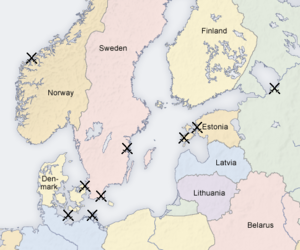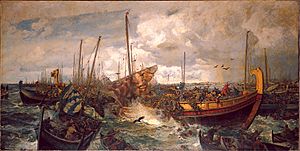Eiríkr Hákonarson facts for kids
Erik Hakonsson (born in the 960s, died in the 1020s) was a powerful Viking leader. He was also known as Eric of Hlathir or Eric of Norway. Erik was an Earl in Norway and later became the Earl of Northumbria in England. He was the son of Earl Hákon Sigurðarson. Erik fought in important battles like the Battle of Hjörungavágr and the Battle of Svolder. He also helped King Canute the Great conquer England.
Contents
What's in a Name? Eric's Many Titles
Erik Hakonsson was called by many names in old writings. In Latin, he was often Yric dux, meaning "Duke Eric". His name was spelled in different ways, like Yric, Iric, or Eiric.
In Old Norse, his language, he was usually Eiríkr jarl ("Earl Eric"). Modern historians often use "Eiríkr Hákonarson". This means "son of Haakon". In modern Norwegian, his name would be Eirik Håkonsson. Some people call him "Eric of Hlathir" because of his earldom in Norway.
Erik's Early Life and First Fight
Stories about Erik's youth come from old sagas like Fagrskinna and Heimskringla. They say Erik was the son of Earl Hákon Sigurðarson. His mother was not from a noble family. Hákon did not raise Erik himself. He gave the boy to a friend to bring up.
One day, when Erik was about eleven, his ship was next to his father's. Hákon's close friend, Skopti, asked Erik to move his ship. Skopti wanted to dock next to Hákon, as he always did. Erik refused, which made his father very angry. Hákon ordered Erik to move his ship. Erik felt very ashamed but had to obey.
That winter, Erik got his revenge. He found Skopti's ship and killed him. This was Erik's first big act as a warrior. A poet named Eyjólfr dáðaskáld wrote about this event. After this, Erik sailed to Denmark. There, King Harald Bluetooth welcomed him. Harald gave Erik control over areas in southern Norway. These lands had long been under Danish influence.
Battle of Hjörungavágr: A Sea Victory
The Battle of Hjörungavágr was Erik's first major battle. It was a sea fight between the Earls of Lade and a Danish invasion fleet. This battle is described in old Norse sagas. These stories are exciting, but historians believe they contain some truth. Some poems from that time also mention the battle.
Erik's father, Hákon Sigurðarson, believed in the old Norse gods. King Harald Bluetooth tried to force Christianity on him. Because of this, Hákon stopped being loyal to Denmark. In 986, a Danish invasion force was defeated at Hjörungavágr. The sagas say Erik commanded 60 ships in this battle. He fought alongside his father and won. After the battle, he showed mercy to many captured warriors.
Years in Exile and Raids
In 995, Óláfr Tryggvason became King of Norway. Erik was forced to leave his home. He went to Sweden and became friends with King Olof of Sweden and King Sweyn. Erik married Sweyn's daughter, Gyða.
From Sweden, Erik launched many raids to the east. He attacked the lands of King Vladimir I of Kiev. Erik looted and burned the town of Staraya Ladoga. There are no other old writings to prove this. However, in the 1980s, archaeologists found proof of a fire in Ladoga around that time. Erik also raided parts of western Estonia and the island of Saaremaa. He fought other Vikings in the Baltic Sea.
Battle of Svolder: A Famous Ambush
In the year 1000, Erik, King Sweyn, and King Olof planned an ambush. They waited for King Óláfr Tryggvason near an island called Svolder. The exact location of this island is unknown today. It was likely off the North German coast.
King Olaf was returning home with his ships. The allies waited for him. Olaf had 71 ships, but some of them belonged to a friend who was secretly working for his enemies. This friend deserted Olaf. Olaf's ships sailed past the ambush in a long line. They did not expect an attack. King Olaf was at the back with his best ships. The allies let most of Olaf's fleet pass. Then, they attacked Olaf's remaining ships.
Olaf refused to run away. He turned to fight with his eleven ships. He tied his ships together side-by-side. His ship, the Long Serpent, was the strongest warship in the north. It was in the middle of the line. This way, all his men could fight. It also made it harder for the enemy to attack from both sides. Olaf turned his ships into a floating fort.
Norse writers say that Erik was the smartest and bravest of Olaf's enemies. They say the Danes and Swedes attacked the front of Olaf's line without success. Erik attacked the side. His ship, the Iron Ram, had strong iron bands on its front. He forced his ship between Olaf's ships. One by one, Olaf's ships were captured. Finally, only the Long Serpent was left. It too was taken. Olaf jumped into the sea, holding his shield. The weight of his armor pulled him down. Erik captured the Long Serpent and sailed it away.
Ruling Norway: A Time of Peace
After the Battle of Svolder, Erik and his half-brother, Sveinn Hákonarson, became rulers of Norway. They ruled under King Sweyn Forkbeard from 1000 to 1012. Erik's son, Hákon Eiríksson, continued this rule until 1015. Erik and Sveinn made their rule stronger by marrying their sister to a powerful ally.
Old sagas say that "there was good peace at this time and very prosperous seasons." The earls kept the laws well. They were strict about punishing crimes. During his rule, Erik's main rival was Erlingr Skjálgsson. They kept an uneasy peace. Erik also made a law against duelling and sent away berserkers.
Conquering England with Canute the Great
In 1014 or 1015, Erik left Norway. He joined Canute the Great for his war in England. Canute was young and not very experienced. But Erik was a skilled warrior. He was "an experienced warrior of tested intelligence and fortune." He was a great advisor for Canute.
The Viking fleet landed in England in midsummer 1015. They met little resistance. Canute's forces moved into Wessex and plundered many areas. An English leader joined Canute with 40 ships.
In early 1016, the Viking army moved into Mercia, plundering as they went. Prince Edmund tried to gather an army, but he failed. Canute's forces continued into Northumbria. There, the Earl of Northumbria was murdered. Canute gave this important earldom to Erik. After taking Northumbria, the army turned south towards London. Before they arrived, King Ethelred the Unready died. Edmund Ironside was chosen as the new king.
The Viking forces then surrounded London. It is believed that Erik oversaw this siege. After several battles, Canute and Edmund agreed to divide the kingdom. But Edmund died a few months later. By 1017, Canute was the undisputed king of all England. He divided England into four parts. He kept Wessex for himself. He gave Northumbria to Erik.
Erik remained Earl of Northumbria until his death. It is interesting that he never fought against the Scots or the Britons. These groups often threatened Northumbria. Erik is not mentioned in English writings after 1023. Some sources say he was sent away by Canute and returned to Norway. But there are no Norse records of him returning. Erik's death likely happened between 1023 and 1033. Norse sources say he died after a medical procedure on his throat. This happened either before or after a trip to Rome.
Erik's Religion: A Smart Choice
Some stories say Erik promised to become a Christian if he won the Battle of Svolder. One story says he replaced a statue of the god Thor on his ship with a Christian cross. There are no poems to prove this. However, most sagas agree that Erik and his brother Sveinn became Christians, at least officially.
One saga says: "These jarls had had themselves baptised, and remained Christian, but they forced no man to Christianity, but allowed each to do as he wished." This means they did not force people to change their religion. This was a smart political move. They were allied with Christian rulers in Sweden and Denmark. Allowing freedom of religion was also wise after King Óláfr Tryggvason had violently forced people to become Christian.
Erik's personal belief as a Christian was probably not very strong. The poets who wrote for Erik's rivals praised their lords as Christians. But the poems written for Erik are still about the old pagan gods. One poem says Erik conquered lands because the heathen gods wanted him to. Even poems written later show no sign of Christian influence.
Where We Learn About Erik
Most of what we know about Erik comes from sagas written in the 12th and 13th centuries. These include Heimskringla and Fagrskinna. English writings from the 11th century, like the Anglo-Saxon Chronicle, also mention him. These are important because they were written closer to his time.
Many poems by Erik's own poets are still around. These poems are very important because they are from his time. They tell us about his battles and life.



